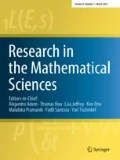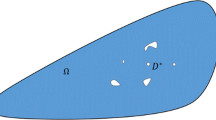Abstract
We are interested in an inverse medium problem with internal data. This problem is originated from multi-waves imaging. We aim in the present work to study the well posedness of the inversion in terms of the boundary conditions. We precisely show that we have actually a stability estimate of Hölder type. For sake of simplicity, we limited our study to the class of Helmholtz equations \(\Delta + V\) with bounded potential V.
Similar content being viewed by others
References
Alessandrini, G.: Global stability for a coupled physics inverse problem. Inverse Probl. 30, 075008 (2014)
Alessandrini, G., Di Cristo, M., Francini, E., Vessella, S.: Stability for quantitative photoacoustic tomography with well chosen illuminations. Ann. Mat. Pura Appl. 196(2), 395–406 (2017)
Alessandrini, G., Rondi, L., Rosset, E., Vessella, S.: The stability for the Cauchy problem for elliptic equations. Inverse Probl. 25(12), 123004 (2009)
Ammari, H., Bonnetier, E., Capdeboscq, Y., Tanter, M., Fink, M.: Electrical impedance tomography by elastic deformation. SIAM J. Appl. Math. 68(6), 1557–1573 (2008)
Ammari, H., Capdeboscq, Y., De Gournay, F., Rozanova-Pierrat, A., Triki, F.: Microwave imaging by elastic perturbation. SIAM J. Appl. Math. 71(6), 2112–2130 (2011)
Ammari, K., Choulli, M., Triki, F.: Hölder stability in determining the potential and the damping coefficient in a wave equation, arXiv:1609.06102
Ammari, H., Garnier, J., Nguyen, L.H., Seppecher, L.: Reconstruction of a piecewise smooth absorption coefficient by an acousto-optic process. Commun. Part. Differ. Equ. 38(10), 1737–1762 (2013)
Bal, G., Ren, K.: Non-uniqueness result for a hybrid inverse problem. Contemp. Math. 559, 29–38 (2011)
Bal, G., Schotland, J.C.: Inverse scattering and acousto-optics imaging. Phys. Rev. Lett. 104, 043902 (2010)
Bal, G., Uhlmann, G.: Reconstruction of coefficients in scalar second order elliptic equations from knowledge of their solutions. Commun. Pure Appl. Math. 66(10), 1629–1652 (2013)
Bonnetier, E., Choulli, M., Triki, F.: Stability for quantitative photo-acoustic tomography revisited (preprint)
Choulli, M.: An introduction to the analysis of elliptic partial differential equations, book (to appear)
Choulli, M., Kayser, L.: Gaussian lower bound for the Neumann Green function of a general parabolic operator. Positivity 19(3), 625–646 (2015)
Choulli, M., Kian, Y.: Logarithmic stability in determining the time-dependent zero order coefficient in a parabolic equation from partial Diriclet-to-Neumann map. Application to the determination of a nonlinear term. J. Math. Pure Appl. 114, 235–261 (2018)
Choulli, M., Triki, F.: New stability estimates for the inverse medium problem with internal data. SIAM J. Math. Anal. 47(3), 1778–1799 (2015)
Choulli, M., Yamamoto, M.: Logarithmic stability of parabolic Cauchy problems, arXiv:1702.06299
Garofalo, N., Lin, F.-H.: Monotonicity properties of variational integrals, \(A_p\) weights and unique continuation. Indiana Univ. Math. J. 35(2), 245–268 (1986)
Garofalo, N., Lin, F.-H.: Unique continuation for elliptic operators: a geometric-variational approach. Commun. Pure Appl. Math. 40(3), 347–366 (1987)
Henrot, A., Pierre, M.: Variation et Optimisation de Formes, vol. 48. SMAI-Springer, Berlin (2005)
Robbiano, L.: Dimension des zéros d’une solution faible d’un opérateur elliptique. J. Math. Pures Appl. 67, 339–357 (1988)
Author's contributions
Acknowledgements
The authors were supported by the Grant ANR-17-CE40-0029 of the French National Research Agency ANR (project MultiOnde).
Author information
Authors and Affiliations
Corresponding author
Appendix A
Appendix A
In this appendix, \(\Omega \) is a bounded domain of \(\mathbb {R}^n\), \(n\ge 2\), with Lipschitz boundary \(\Gamma \). Let
where \(V\in L^\infty (\Omega )\), \(A=(a^{ij})\) is a symmetric matrix with coefficients in \(W^{1,\infty }(\Omega )\) and there exist \(\kappa >0\) and \(\Lambda >0\) so that
and
Recall the following three-ball interpolation inequality, proved in [11] when \(V=0\) but still holds for any bounded V (see also [12]).
Theorem A.1
Let \(0<k<\ell <m\). There exist \(C>0\) and \(0<s <1\), only depending on \(\Omega \), k, \(\ell \), m, \(\kappa \) and \(\Lambda \), such that
for all \(v\in H^1(\Omega )\) satisfying \(Lv=0\) in \(\Omega \), \(y\in \Omega \) and \(0<r< \text{ dist }(y,\Gamma )/m\).
We know from [19, Theorem 2.4.7, page 53] that any Lipschitz domain has the uniform interior cone condition, abbreviated to UICP in the sequel. In particular, there exist \(R>0\) and \(\theta \in \left]0,\frac{\pi }{2}\right[\) so that, to any \(\tilde{x}\in \Gamma \) corresponds \(\xi =\xi (\tilde{x})\in \mathbb {S}^{n-1}\) for which
Define the geometric distance \(d_g^D\), on a bounded domain D of \(\mathbb {R}^n\), by
where
is the length of \(\psi \).
Note that, according to Rademacher’s theorem, any Lipschitz continuous function \(\psi :[0,1]\rightarrow D\) is almost everywhere differentiable with \(|\dot{\psi }(t)|\le k\) a.e. \(t\in [0,1]\), where k is the Lipschitz constant of \(\psi \).
Lemma A.1
Let D be a bounded Lipschitz domain of \(\mathbb {R}^n\). Then \(d_g^D\in L^\infty (D \times D )\).
A proof of this lemma can be found in [16].
In the rest of this text
Proof
(Proof of Theorem 2.1) In this proof C denotes a generic constant that can depend only on \(\Omega \), \(v_0\), \(V_0\), \(\kappa \) and M.
Step 1. Let \(y, y_0\in \Omega ^{3\delta }\) and \(\psi :[0,1]\rightarrow \Omega \) be a Lipschitz path joining \(y_0\) to y so that \(\ell (\psi )\le d_g^\Omega (y_0,y)+1\). Let \(t_0=0\) and \(t_{k+1}=\inf \{t\in [t_k,1]; \psi (t)\not \in B(\psi (t_k),\delta )\}\), \(k\ge 0\). We claim that there exists an integer \(N\ge 1\) so that \(\psi (1)\in B(\psi (t_N),\delta )\). If not, we would have \(\psi (1)\not \in B(\psi (t_k),\delta )\) for any \(k\ge 0\). As the sequence \((t_k)\) is nondecreasing and bounded from above by 1, it converges to \(\hat{t}\le 1\). In particular, there exists an integer \(k_0\ge 1\) so that \(\psi (t_k)\in B\left( \psi (\hat{t}),\delta /2\right) \), \(k\ge k_0\). But this contradicts the fact that \(\left| \psi (t_{k+1})-\psi (t_k)\right| =\delta \), \(k\ge 0\).
Let us check that \(N\le N_0\), where \(N_0\) only depends on \(\mathbf {d}_g\) and \(\delta \). If \(\psi =(\psi _1,\ldots ,\psi _n)\), we pick \(1\le j\le n\) so that
Then
Consequently, where \(t_{N+1}=1\),
Therefore
Here \(\left[ n(\mathbf {d}_g+1)/\delta \right] \) is the integer part of \(n(\mathbf {d}_g+1)/\delta \).
Let \(y_k=\psi (t_k)\), \(0\le k\le N\). If \(|z-y_{k+1}|<\delta \) then
In other words, \(B(y_{k+1},\delta )\subset B(y_k,2\delta )\).
We get from Theorem A.1
Set \(I_j=\Vert u\Vert _{L^2(B(y_j,\delta ))}\), \(0\le j\le N\) and \(I_{N+1}=\Vert u\Vert _{L^2(B(y,\delta ))}\). Since \(B(y_{j+1},\delta )\subset B(y_j,2\delta )\), \(1\le j\le N-1\), estimate (A.4) implies
where we set \(M_0=\Vert u\Vert _{L^2(\Omega )}\).
Let \(C_1=C^{1+s+\ldots +s^{N}}\) and \(\beta =s^{N+1}\). Then, by a simple induction argument, estimate (A.5) yields
Without loss of generality, we assume in the sequel that \(C\ge 1\) in (A.5). Using that \(N\le N_0\), we have
These estimates in (A.6) gives
In other words,
Applying Young’s inequality, we get from this inequality
\(\epsilon >0\), \(y,y_0\in \Omega ^{3\delta }\).
Step 2. Fix \(\tilde{x}\in \Gamma \) so that \(|u(\tilde{x})|=\Vert u\Vert _{L^\infty (\Gamma )}\). Let \(\xi =\xi (\tilde{x})\) be as in the definition of the UICP. Let \(x_0=\tilde{x}+\delta \xi \), \(\delta \le R/2\), \(d_0=|x_0-\widetilde{x}|=\delta \) and \(\rho _0=d_0\sin \theta /3\). Note that \(B(x_0,3\rho _0)\subset \mathcal {C}(\tilde{x})\).
By induction in k, we construct a sequence of balls \((B(x_k, 3\rho _k))\), contained in \(\mathcal {C}(\tilde{x})\), as follows
where
with
Note that this construction guarantees that, for each k, \(B(x_k,3\rho _k)\subset \mathcal {C}(\tilde{x})\) and
We get, by applying Theorem A.1, that there exist \(C>0\) and \(0<s<1\), only depending on \(\Omega \), \(v_0\) and \(V_0\), so that
In light of (A.8), (A.9) gives
Let \(J_k=\Vert u\Vert _{L^2(B(x_k,\rho _k))}\), \(k\ge 0\). Then (A.10) is rewritten as follows:
An induction in k yields
That is
Applying Young’s inequality we obtain, for any \(\epsilon >0\),
Now, since \(u\in C^{0,1/2}(\overline{\Omega })\),
Hence
Or equivalently
A simple computation shows that \(d_k=\mu ^kd_0\). Then
Therefore,
implying, when \(d_0 (=\delta ) \le 1\),
Inequalities (A.12) and (A.13) give
We get, by choosing \(\epsilon =\mu ^{(1-s^k)(n+1)k/2}\) in (A.14),
Hence
by using \(\delta \le \text{ diam }(\Omega )\).
Let \(t>0\) and k be the integer so that \(k\le t<k+1\). It follows from (A.15)
Let \(p =(n+1)/2+|\ln s|\). Then (A.16) yields
Putting \(e^{p t}=1/\epsilon \), \(0<\epsilon <1\), we get from (A.17)
where \(\beta = |\ln \mu |/(2p)\).
Step 3. A combination of (A.7) and (A.18) entails, with \(0<\epsilon <1\) and \(\epsilon _1>0\),
Hence, where \(\ell =n/2\) and \(\rho =|\ln \mu |\),
In this inequality, we take \(\epsilon _1=\epsilon ^{\beta (1-\psi (\delta ))}e^{-\rho (1-\psi (\delta ))/\epsilon }\). Using that
we obtain in a straightforward manner
If \(\phi (\delta )=\rho +(\rho +\beta )(1-\psi (\delta ))/\psi (\delta )\) then we can rewrite the previous estimate as follows:
or equivalently
If \(M/\Vert u\Vert _{L^2(B(y_0,\delta ))}> e^{\phi (\delta )}\), we find \(t>1\) so that \(M/\Vert u\Vert _{L^2(B(y_0,\delta ))}=t^\beta e^{t\phi (\delta )}\). The estimate (A.19) with that t yields
In light of the inequality \(\Vert u\Vert _{L^\infty (\Gamma )}\ge \eta \), this estimate implies
This inequality is equivalent to the following one
Otherwise,
We derive from (A.20) and (A.21) that, there exist \(C>0\) and \(\delta ^*\) so that
Obviously, a similar estimate holds for \(\delta \ge \delta ^*\). \(\square \)
Rights and permissions
About this article
Cite this article
Choulli, M., Triki, F. Hölder stability for an inverse medium problem with internal data. Res Math Sci 6, 9 (2019). https://doi.org/10.1007/s40687-018-0171-z
Received:
Accepted:
Published:
DOI: https://doi.org/10.1007/s40687-018-0171-z



